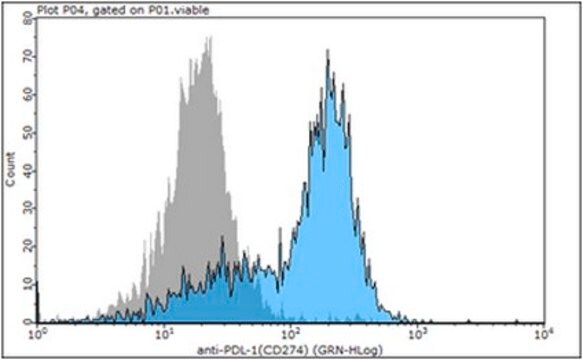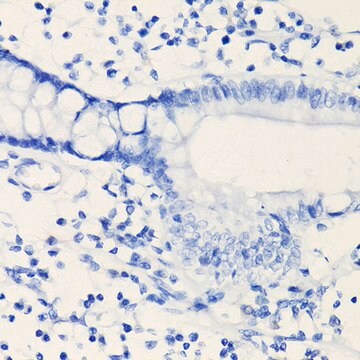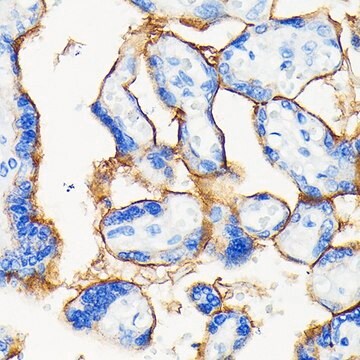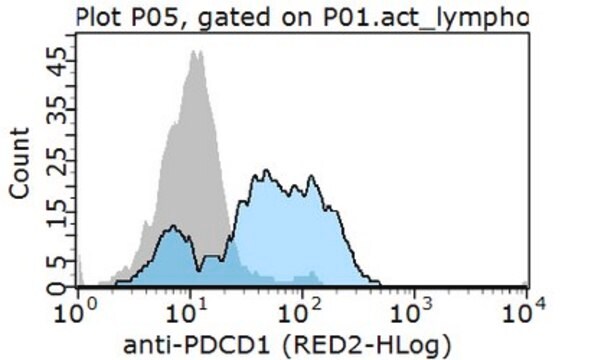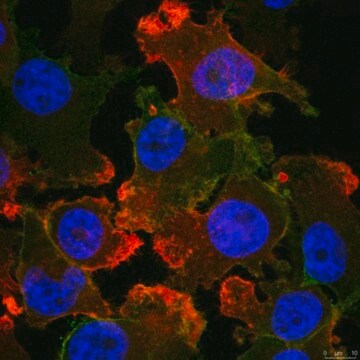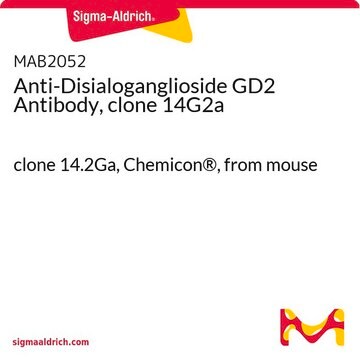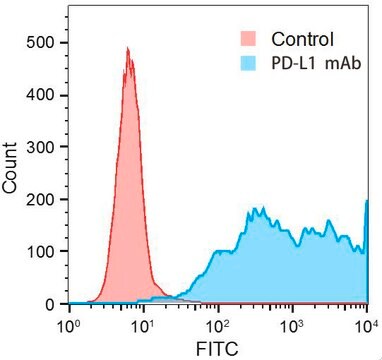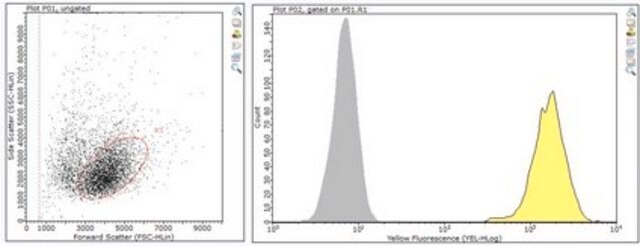MABC980
Anti-PD-L1 Antibody, clone 29E.2A3.C6, Azide Free
clone 29E.2A3.C6, from mouse
Sinónimos:
Programmed cell death 1 ligand 1, B7-H1, B7 homolog 1, CD274, PD-L1, PDCD1 ligand 1, Programmed death ligand 1
About This Item
Productos recomendados
biological source
mouse
Quality Level
antibody form
purified immunoglobulin
antibody product type
primary antibodies
clone
29E.2A3.C6, monoclonal
species reactivity
rat, chimpanzee, human
technique(s)
flow cytometry: suitable
immunocytochemistry: suitable
immunohistochemistry: suitable (paraffin)
neutralization: suitable
isotype
IgG2bκ
NCBI accession no.
UniProt accession no.
shipped in
dry ice
target post-translational modification
unmodified
Gene Information
human ... CD274(29126)
General description
Specificity
Immunogen
Application
Flow Cytometry Analysis: 0.1 µg of this antibody from a representative lot detected PD-L1 in MDA-MB-231 cells.
Flow Cytometry Analysis: A representative lot immunostained the surface of 300.19 murine pre-B lymphoma cells transfected with human PD-L1, but not the untransfected cells or cells transfected with human PD-L2 (Brown, J.A., et al. (2003). J. Immunol. 170(3):1257-1266).
Flow Cytometry Analysis: A representative lot detected surface PD-L1 expression on human breast cancer cell lines MDA-231, SKBR-3, and MCF-7, but not BT-474 (Latchman, Y., et al. (2001). J. Nat. Immunol.2(3):261-268).
Immunohistochemistry Analysis: A representative lot detected PD-L1 expression pattern in frozen fetal (thymus & cardiac tissue) and paraffin-embedded adult (tonsillar germinal center and placenta) human tissue sections (Brown, J.A., et al. (2003). J. Immunol. 170(3):1257-1266).
Immunohistochemistry Analysis: A representative lot detected PD-L1 expression in paraffin-embedded human cancer tissue sections, including anaplastic large cell lymphoma, squamous cell carcinoma of the tongue, colon adenocarcinoma, and invasive breast ductal carcinoma (Brown, J.A., et al. (2003). J. Immunol. 170(3):1257-1266).
Neutralizing Analysis: A representative lot competed against human PD-1 extracellular domain Ig fusion for the binding of exogenously expressed human PD-L1 on the surface of 300.19 murine pre-B lymphoma cells (Brown, J.A., et al. (2003). J. Immunol. 170(3):1257-1266).
Neutralizing Analysis: A representative lot enhanced cytokines production from CD4 T-cells upon HIV Gag peptides stimulation of CD8+-depleted human PBMCs (Porichis, F., et al. (2011). Blood. 118(4):965-974).
Neutralizing Analysis: A representative lot restored HCV peptides-induced expansion of CD8+ T cells in cultured intrahepatic lymphocytes from a chimpanzee with 10 years of chronic HCV infection (Fuller, M.J., et al. (2013). Proc. Natl. Acad. Sci. U. S. A. 110(37):15001-15006).
Neutralizing Analysis: Dual blockage of both DP-L1 clone 29E.2A3.C6 Fab fragment and DP-L2 by clone 24F.10C12 (Cat. No. MABC969) Fab fragment on PBMC-derived dendric cells (DCs) boosted the enhancing effect on CD4+ T-cell proliferation and cytokine release seen with DP-L2 blockage alone in allogenic cultures with immature DCs (iDC), mature DCs (mDC), and IL-10-treated mDCs (Brown, J.A., et al. (2003). J. Immunol. 170(3):1257-1266).
Immunocytochemistry Analysis: A representative lot detected an upregulated PD-L1 immunoreactivity in human CD14+ monocyte-derived macrophages (MDMs) following HIV infection or TLR4/8 stimulation (by LPS or CL097 treatment) by fluorescent immunocytochemistry using paraformaldehyde-fixed MDMs (Rodríguez-García, M., et al. (2011). J. Leukoc. Biol. 89(4) 507–515).
Apoptosis & Cancer
Apoptosis - Additional
Quality
Immunohistochemistry Analysis: An 1:50 dilution of this antibody detected PD-L1 in human cerebral cortex tissue.
Target description
Physical form
Storage and Stability
Handling Recommendations: Upon receipt and prior to removing the cap, centrifuge the vial and gently mix the solution. Aliquot into microcentrifuge tubes and store at -20°C. Avoid repeated freeze/thaw cycles, which may damage IgG and affect product performance.
Other Notes
Disclaimer
¿No encuentra el producto adecuado?
Pruebe nuestro Herramienta de selección de productos.
Optional
Storage Class
12 - Non Combustible Liquids
wgk_germany
WGK 2
flash_point_f
Not applicable
flash_point_c
Not applicable
Certificados de análisis (COA)
Busque Certificados de análisis (COA) introduciendo el número de lote del producto. Los números de lote se encuentran en la etiqueta del producto después de las palabras «Lot» o «Batch»
¿Ya tiene este producto?
Encuentre la documentación para los productos que ha comprado recientemente en la Biblioteca de documentos.
Nuestro equipo de científicos tiene experiencia en todas las áreas de investigación: Ciencias de la vida, Ciencia de los materiales, Síntesis química, Cromatografía, Analítica y muchas otras.
Póngase en contacto con el Servicio técnico